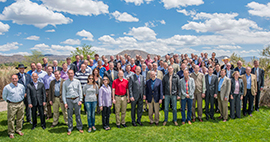ALBUQUERQUE, N.M. — NATO delegates toured Sandia National Laboratories during a three-day visit highlighting the labs’ programs that support extended deterrence to U.S. allies, as well as broader national security programs ranging from homeland security to preventing the proliferation of weapons of mass destruction.
The visitors included more than 50 representatives from 23 European countries, along with officials from the Department of Defense, the National Nuclear Security Administration, the State Department and other U.S. government agencies.
The delegates were accompanied by Andrew Weber, assistant secretary of defense for nuclear, chemical and biological defense programs, and by Elaine Bunn, deputy assistant secretary of defense for nuclear and missile defense policy.
Sandia President and Laboratories Director Paul Hommert, welcoming the visitors on Wednesday, presented an overview of the Laboratories’ history, from its beginnings in the World War II Manhattan Project to build the first atomic bombs, to a focus on nuclear weapons components manufacturing that gave birth to Sandia as a separate laboratory in 1949. He outlined Sandia’s focus on nuclear weapons safety and security through the 1950s and its subsequent evolution into broader national security research, including energy and a variety of Department of Defense work.
Hommert also emphasized that the highly diverse laboratory Sandia has become remains focused on its core responsibility, nuclear weapons life extension programs.
“We are in full gear to execute this mission” with the alliance in mind, Hommert said.
The visit aimed at demonstrating the science, engineering, and technology required to implement U.S. policies that support the alliance. The agenda included an overview of national security and nuclear weapons programs at Sandia, Los Alamos and Lawrence Livermore national laboratories and the NNSA’s nuclear weapons enterprise, as well as mission briefings for the Defense Threat Reduction Agency and the Air Force Nuclear Weapons Center on Kirtland Air Force Base.
Sandia officials also demonstrated various capabilities associated with the labs’ pivotal role in life extension programs. The delegates took a windshield tour of Sandia’s large-scale experimental test areas, saw demonstrations of nuclear incident response equipment and viewed exhibits about homeland and global security programs.
The Defense Threat Reduction Agency provided briefings on how they support nuclear surety and inspections, as well as the on-site inspection program activities that support treaty verification activities.
Five members of the delegation participated in a National Security Speakers Series panel, moderated by Bunn. The panel addressed U.S. allies’ views of extended deterrence, the role of NATO member states in the nuclear deterrent and arms control negotiations. The session drew a standing-room-only crowd of Sandians, which Hommert said demonstrated that “our staff understands that if it says ‘life extension program,’ it’s important.”

